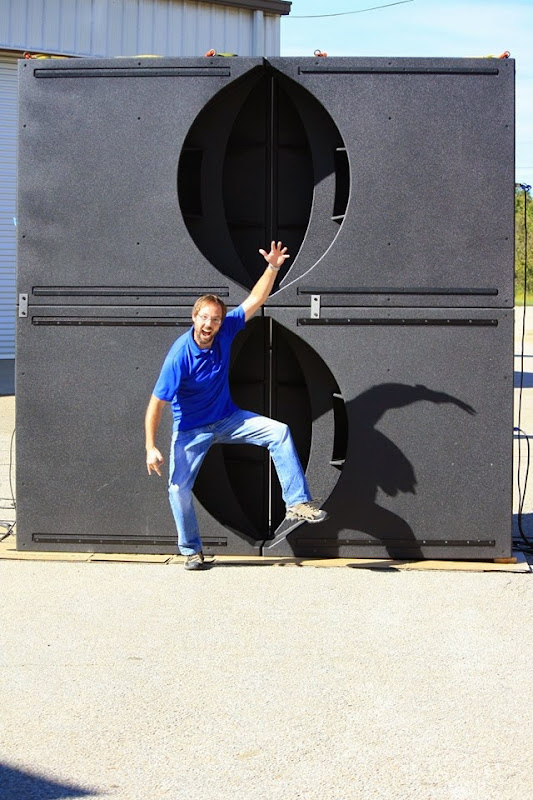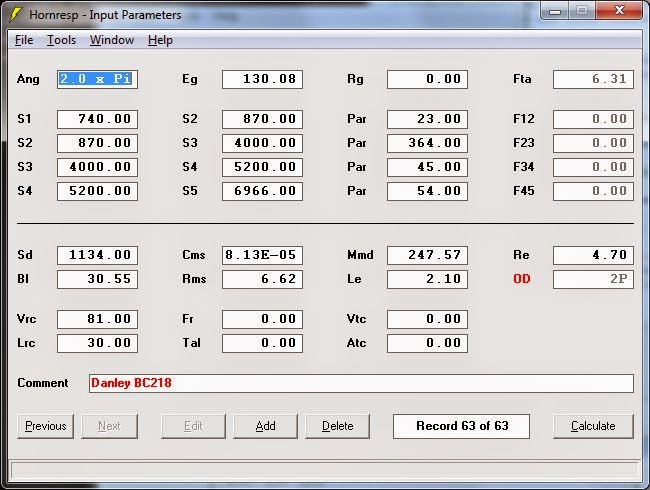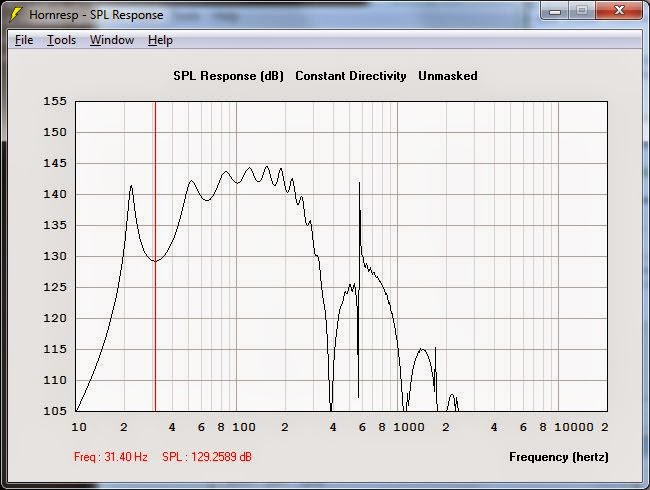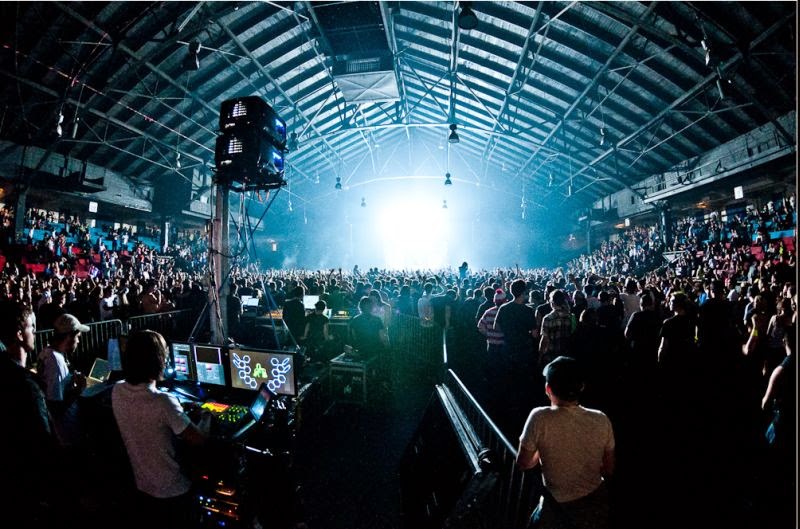Danley posted some pics on his Facebook of a new sub today.
These things are truly getting silly, this one is designed to be assembled into a 10' tall array. While everyone else is getting cardioid response with digital trickery, Danley is doing it with a sub that's taller than the room you're sitting in :O






This pic gives you a good idea of the horn folding. We can use this to guess what the response, output, and F3 is like.

These things are truly getting silly, this one is designed to be assembled into a 10' tall array. While everyone else is getting cardioid response with digital trickery, Danley is doing it with a sub that's taller than the room you're sitting in :O






This pic gives you a good idea of the horn folding. We can use this to guess what the response, output, and F3 is like.
Here's my guess at the folding. We know that the width is 5'.
A 5' long duct resonates at 56.25hz. So there's either one fold (28hz) or two folds (19hz).
Since they said it's good for 20hz, I'm guessing two folds, but I may be wrong. It may be a single fold.

Here's my guess. I'm basing this on what the mouth looks like, and where the woofers are mounted. (We can tell from the access panels.)

Here's a hornresp model of my guess, using the 18 Sound 18NLW9600

Here's the predicted output with 7,200 watts into 3.3 ohms.
Yowza that's a lot of bass.
With four in an array it should be possible to exceed 150dB(!)
A 5' long duct resonates at 56.25hz. So there's either one fold (28hz) or two folds (19hz).
Since they said it's good for 20hz, I'm guessing two folds, but I may be wrong. It may be a single fold.

Here's my guess. I'm basing this on what the mouth looks like, and where the woofers are mounted. (We can tell from the access panels.)

Here's a hornresp model of my guess, using the 18 Sound 18NLW9600

Here's the predicted output with 7,200 watts into 3.3 ohms.
Yowza that's a lot of bass.
With four in an array it should be possible to exceed 150dB(!)

There's a brutal dip in the predicted output.
Then again, arraying horns smooths out the response, as illustrated above.
Also, this is something I haven't heard discussed much, but horn dips and peaks are harmonic. For instance, if you're listening to a recording with a drum strike at 22hz, there will be harmonics at 44hz, 66hz, etc. And a horn sub keeps those harmonics intact.
On the flipside of this, if there's a drum strike at 35hz, where the horn has a big dip, the harmonics at 70hz will come through loud and clear.
IE, it's worse to have a peak or dip at 80hz than at 25hz. If you have a peak or dip at 80hz, it's going to screw up the sound of all the fundamentals at 40hz. (Because 80hz is a harmonic of 40hz.)
But a peak or dip at 35hz isn't going to cause any audible issues. If there's a sound at 35hz you'll hear the harmonic at 70hz.
True, we'd LIKE to have flat response to 20hz, but it's better to have a peak or dip at 35hz than at sixty, seventy, or eight hertz.
If that's the fold, wouldn't there be some removable panels at the rear to gain access to the drivers?
The access panels are in the top right and the bottom right. That's how we know where the drivers are. (You can see the access panels in the photos.)
I don't agree with the way he stack them(shallow and big surface) would be much cooler if he stacked them deep, laying down...
I wonder if the way they're stacked has any sort of the same effect as a slot load? It looks as though the "eye" opening is quite a bit smaller than the combined terminus.
In any event, I'm terribly jealous of the folks that get to work for DSL, it's never a boring day!

I wonder if the Danley design is a plain bass horn or if it may be tapped? Basically the blue area for the bass horn rear chamber would be removed exposing the driver back to the flow. The path is still the same now if a TH, gains additional extension and efficiency. Did DSL post any measured freq responses?
Very rough estimate of bass extension is 3 x 1.5m=4.5m path. 342m/s / 4.5m / 4-wave=19Hz.
Very rough estimate of bass extension is 3 x 1.5m=4.5m path. 342m/s / 4.5m / 4-wave=19Hz.
Last edited:
I wonder if the way they're stacked has any sort of the same effect as a slot load? It looks as though the "eye" opening is quite a bit smaller than the combined terminus.
In any event, I'm terribly jealous of the folks that get to work for DSL, it's never a boring day!
If I understood you correctly, I somewhat agree with you. I'm not familiar with slot loading so I can't comment on that, but to my very limited knowledge I think, for being a FLH(what I think it is), the total mouth area in relation to the internal volume seem somewhat small. The general consensus afaik is that the mouth area in flh designs are in direct relation with generated spl, but his BC cabs are similar(compressing at mouth) but I just think it looks bad. And not as mean as 'conservatively' stacked FLH's.
The large frontal area of the DSL BC218 increases forward gain while reducing rear output, the classic "barn door" effect. The curved mouth exit is probably more effective at utilizing the large frontal area as the mouth of the horn than the prior 22.5" deep DSL FLH, the DBH 218LF.What gives it cardioid response?
The BC218 is 30" x 60" x 60".
For users that want higher frontal density (but lesser cardioid effect), a pair of BC218 and central "double cutaway" versions can be used.
"Patrick Bateman's" "reverse engineering" shows the loudspeakers reversed from the actual design, and the sim does not seem to consider the frontal area as part of the horn, a specific design feature of the DSL "BC" series of horns.
Art
Attachments
What gives it cardioid response?
Glad you asked! I agree with Art, but here's some pics I made to wrap my brain around what's going on.


This is revision one of the Skrillex Cell. I've been to many, many shows and I'd never heard anything like this in my life. One of three shows I've ever been to where it felt like there was so much bass, they might damage the building. I have a difficult time describing how big this system was, because I'm fairly certain 95% of the people in the world have never felt something like this. (This is from the actual show that I went to.)

Here's the PK setup from the 'Full Flex' tour, a year later. We have a good view of what's making all that bass - there's an array of sixty four eighteens across the stage.

Here's the Danley Sound Labs setup for Miami Music Week, with four BC415s. (Courtesy of Pure Groove Systems.)


Here's the same set of speakers, this time for Nocturnal Wonderland, here in California.
Okay, in the next post I'll upload the diagrams I made...

In the last post, and in some other threads, I've talked about how a handful of these setups can generate absolutely skull crushing bass. And yet I've heard smaller versions of the setups, and they were completely forgettable. Even anemic.
While pondering the Danley BC subs, I realized that they can generate signficant forward directivity due to the size of the array.
The pic above shows four different setups.
The first setup on the left is the 'Full Flex Express' setup. Due to the width of the array, it should create a flat wavefront down to 16.93hz(!!!)
To the right of that is the setup used at 'Nocturnal Wonderland.' Due to the array width, you get forward directivity down to 55.32hz. Note that if you doubled the array width you'd go all the way down to 27.6hz.
I think one of the most interesting configurations is the one used in Miami. With the exact same subwoofers, you can get forward directivity down to around 30hz, by putting a gap between the array. But the pattern is more complex, and will have side lobes. It's fairly similar to what happens in a D'Appolito array, where you get reduced output to the floor and ceiling and more output to the front. But because the subwoofer array is horizontal, not vertical, those side nulls go to the side walls.

Of course you don't need a horn to get directivity. But what the Danley solution offers is dramatically reduced COST. I've illustrated this by showing what the cost of the woofers is in the various setups above. The PK setup used by Skrillex has about forty five thousand dollars worth of woofers in the array. And that's just the parts cost! Factor in the amps, the cabs, etc, and you're looking at a very, very expensive subwoofer array.
The big complaint about horns is that they're too big. Horns give you a lot of 'bang for the buck', but they're LARGE. The BC boxes turn a 'defect' into a 'feature'; they use their physical size to increase directivity.
I don't know what woofer is in the BC415, but if it's similar to the 15TBX100, then the horn sub array can offer directivity that's similar to that monster PK setup, at a small fraction of the price.
WIN-WIN
Also, I know a lot of what we talk about on diyaudio is academic. But if you have an opportunity to hear a setup like this, take it. Even if you don't like the music. Directional bass is truly an amazing thing. It's funny because it seems like only a tiny fraction of the live venues have figure out how to do it. I read some reviews of the Bonnarro festival, and numerous attendees were complaining that the bands had to play so quietly, it was difficult to even hear the words. The reason that venues have to do this is that a lot of festivals have multiple bands playing simultaneously. For instance, The Vans Warped Tour has 4-6 stages all playing simultaneously. With directional arrays, the sound is magical. With conventional setups, it's a quiet muddled mess.
Patrick,While pondering the Danley BC subs, I realized that they can generate signficant forward directivity due to the size of the array.
The first setup on the left is the 'Full Flex Express' setup. Due to the width of the array, it should create a flat wavefront down to 16.93hz(!!!)
Any directivity achieved with a horizontal line of woofers is dependent on destructive interference within the line's horizontal boundaries, the frequency response in the coverage area reflects it is anything but a "flat wavefront", a muddled mess that kind of averages out over the coverage area. There are several array calculators that show the peaks and nulls graphically at any frequency you care to examine with a variety of arrays, horizontal, end fire, and cardioid.
The BC218 offers a variety of directional set ups with the virtual point source still within 1/4 wavelength over most of the pass band, so the output is not a series of distributed peaks and nulls as with a long horizontal line of subs. The large frontal area is reflected in a virtual floor boundary doubling, which gives vertical directivity, lacking in the horizontal arrays.
Patrick,
Any directivity achieved with a horizontal line of woofers is dependent on destructive interference within the line's horizontal boundaries,
Of course. That's why I included pics of the venue for the Skrillex setup. You can see that part of the reason the output was so bone crushing is that the width of the subwoofer array was nearly half the width of the building. The same effect wouldn't be possible outside. The walls were concrete, which helped a lot as well.
the frequency response in the coverage area reflects it is anything but a "flat wavefront", a muddled mess that kind of averages out over the coverage area. There are several array calculators that show the peaks and nulls graphically at any frequency you care to examine with a variety of arrays, horizontal, end fire, and cardioid.
I gotta admit that I'm starting to like arrays. I heard the L'Acoustic setup at Nine Inch Nails earlier this month and it was exquisite.
In the case of the PK subwoofer array, it's not difficult to generate a flat wavefront, because the wavelenghts are so long. 40hz is 8.5 meters long, longer than a car. Due to that, it's easy to get them to sum.
I think the BC setup that Pure Groove Systems used is pretty 'trick.' I need to sim it, but I have a 'hunch' that spacing out the array elements should create off-axis nulls. Clever.
The BC218 offers a variety of directional set ups with the virtual point source still within 1/4 wavelength over most of the pass band, so the output is not a series of distributed peaks and nulls as with a long horizontal line of subs. The large frontal area is reflected in a virtual floor boundary doubling, which gives vertical directivity, lacking in the horizontal arrays.
That's awesome, especially for an outdoor event like Nocturnal.
I've been going to Insomniac Events since the early 90s, back when Pasquale was in high school, and they've always been chasing after an 'over the top' Disneyland type of experience. (Pasquale even got married at Disneyland, and has made no bones about trying to mimic what Walt Disney did.)
Basically the Danley subs are perfect for that type of event. Now if they could only get them on the main stage...
Here's an A/B comparison of the two systems. Here's a few things you might notice:
1) The Danley system is so eerily clean, it almost sounds like the original recording, despite the fact they're playing outdoors in a venue with thousands of people. Crazy accurate!
2) A tell-tale sign of massive walls of bass is that the mic will go out when the beat drops. This doesn't happen with the Danley set up I'm guessing that four BC 415s isn't sufficient, particularly since they're outdoors. Then again, this show was at an Indian casino and they may have imposed SPL limitations. (My first rave, back in 1992, was on these tribal grounds.)
I'm guessing that four BC 415s isn't sufficient, particularly since they're outdoors. Then again, this show was at an Indian casino and they may have imposed SPL limitations. (My first rave, back in 1992, was on these tribal grounds.)
3) The PK system has that noticeable 'swishiness' that you get with line arrays. I didn't notice this at all with the L'Acoustic setup this month.
Anyways, watch for yourself and decide:
https://www.facebook.com/video.php?v=689673804462030
Dual Danley Jerich horns and four BC-415s
https://www.youtube.com/watch?v=bTwx3nm_QCE&t=2m40s
Dual PK Sound line arrays and a big pile of CX800 vented boxes. Note how the mic goes AWOL around 2:50 as the beat drops. BASSSSSS!!!
1) The Danley system is so eerily clean, it almost sounds like the original recording, despite the fact they're playing outdoors in a venue with thousands of people. Crazy accurate!
2) A tell-tale sign of massive walls of bass is that the mic will go out when the beat drops. This doesn't happen with the Danley set up
3) The PK system has that noticeable 'swishiness' that you get with line arrays. I didn't notice this at all with the L'Acoustic setup this month.
Anyways, watch for yourself and decide:
https://www.facebook.com/video.php?v=689673804462030
Dual Danley Jerich horns and four BC-415s
https://www.youtube.com/watch?v=bTwx3nm_QCE&t=2m40s
Dual PK Sound line arrays and a big pile of CX800 vented boxes. Note how the mic goes AWOL around 2:50 as the beat drops. BASSSSSS!!!
Note how the mic goes AWOL around 2:50 as the beat drops. BASSSSSS!!!
Some of that is probably some degree of terrible-ness in the cel phone mic, although I would love to see Danley vs PK if they compared them using about equal driver SDs and amplifier power.
A touring system here in the UK visits one of the venues I work at annually.
Its called Valve. The sub array (also doubles as crowd barrier) is just a bunch of 18" BLHs. They pretty much cover the full width of our biggest venue. Amps are just a bunch of really big QSCs.
Its certainly loud. The sort of loud where your vision blurs at different frequencies according to what's playing.
Chris
PS - point #1 above is what I try to achieve with my PA. Its nothing huge, but I try to make sure its something I could listen to at home and not want for more detail/depth/whatever.
Its called Valve. The sub array (also doubles as crowd barrier) is just a bunch of 18" BLHs. They pretty much cover the full width of our biggest venue. Amps are just a bunch of really big QSCs.
Its certainly loud. The sort of loud where your vision blurs at different frequencies according to what's playing.
Chris
PS - point #1 above is what I try to achieve with my PA. Its nothing huge, but I try to make sure its something I could listen to at home and not want for more detail/depth/whatever.
It's nice you're trying to figure this out, but at the point of needing $$$$$ rigging equipment and tractor trailers to carry/transport your audio setup, I'd think it would be silly to "try" to create your own. This system is clearly designed for pro touring or church install or high output install theaters. I don't think they're marketing these cabinets towards a weekend warrior who wants to try to transport his own system.
But if you do figure this out and build it, let us know how it goes!!
And without the rigging equipment, good luck safely trying to lift those upper cabinets into place. I'm guessing 500+ lbs a piece
But if you do figure this out and build it, let us know how it goes!!
And without the rigging equipment, good luck safely trying to lift those upper cabinets into place. I'm guessing 500+ lbs a piece
Last edited:
- Status
- This old topic is closed. If you want to reopen this topic, contact a moderator using the "Report Post" button.
- Home
- Loudspeakers
- Subwoofers
- Another Hopeless Attempt At Reverse Engineering a Danley Design

